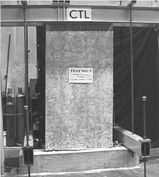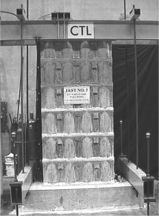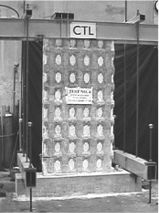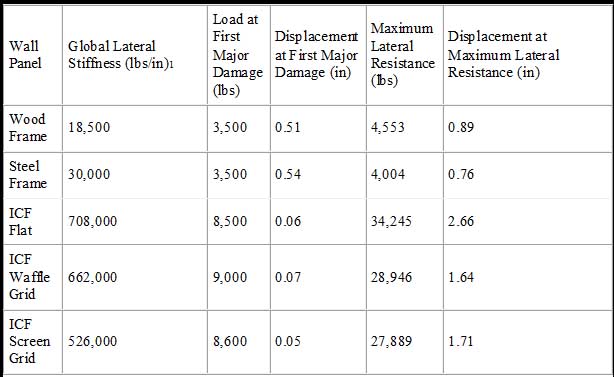Research was conducted to compare the ability of insulating concrete form (ICF) walls, and conventionally framed walls, to resist structural stresses that can occur during earthquakes. All of the walls were tested by applying a sideward or lateral force along the top edge of each wall, in line with the plane of the wall, while restraining the bottom. This "racking" of the specimens creates internal tearing or shear forces as the top of the wall tries to move while the bottom of the wall remains stationary. The concrete walls demonstrated significantly higher structural capacity and stiffness to resist the in-plane shear forces than wood or steel frame walls.
What type of walls were tested?
One wall specimen for each of five types of exterior residential wall systems were tested, each 8 feet high and 4 feet wide. Three of the wall specimens were built with ICFs, creating one flat concrete wall, a waffle grid concrete wall, and a screen grid concrete wall, all shown below. The walls were reinforced with grade 60 steel rebars. Additional steel extended from the top of the footing into each wall. The nominal compressive strength of the concrete used in the wall panels was 2,500 psi. No finishes were applied to the surfaces of the wall specimens. Loads were applied to a concrete beam secured to the top of the wall panels with high strength anchor bolts to transfer the lateral forces to the top of the specimens. The foam plastic formwork was removed from one side of each panel to permit the performance of the concrete to be observed.

Flat ICF Wall

Waffle Grid ICF Wall

Screen Grid ICF Wall
The two frame walls consisted of: a 2 x 4 wood stud specimen, and a 20-gauge steel stud specimen. The framing was covered with 7/16-inch OSB (Oriented Strand Board) on one side and gypsum wallboard on the other. The frame walls were secured to concrete footings with steel hold-downs anchoring the ends, and with embedded anchor bolts at two intermediate locations. A 6-inch deep timber beam was firmly attached to the top of the frame wall specimens to transfer the lateral forces to the top of the panels.
How was in-plane shear resistance measured?
The structural details for the test specimens were adopted based on design recommendations and guidelines for typical exterior wall panels in earthquake zones 1 or 2, and for minimum wind speed of up to 70 miles per hour. The test setup and procedure followed general guidelines of ASTM E564-95, Standard Practice for Static Load Test for Shear Resistance of Framed Walls for Buildings.
A hydraulic ram was used to transfer lateral load to the beam at the top of each wall. A calibrated instrument measured the increasing magnitude of this load. Additional devices were used to measure any movement of the panels or footing. The amount of load was gradually increased while any major distress, cracking, or damage was observed and recorded. The loading was typically continued beyond the peak loading capacity of each wall and testing terminated when the strength of each wall was significantly reduced due to excessive damage to the wall specimens.
How does the shear resistance compare?
The frame walls showed initial damage at relatively light loading and had a much lower maximum lateral resistance. The ICF walls resisted a maximum lateral load 6 to 8 times the maximum loads resisted by the frame wall panels. Under lateral loads of about twice as much as the maximum resistance of the frame walls, the ICF panels were still very stiff, with extremely small deformation, and showed no damage. The table below summarizes the actual results for each tested wall panel.
In-Plane Shear Wall Testing and Loading Results:

1 Global Lateral Stiffness at 1/3 the maximum lateral force resistance for the wood and steel frame, at a lateral load of 5,000 lbs. for the ICF walls.
What does this difference mean?
These results suggest that when subjected to lateral in-plane loading from sources such as wind or earthquake, the ICF wall panels are not only considerably stronger but also much stiffer than the framed wall panels. The higher strength of ICF walls enable concrete homes to resist winds and earthquakes of much higher magnitudes. The higher stiffness demonstrated by the ICF wall panels at the loading limits of the frame wall systems, would result in smaller lateral deformation and prevention of potential damage to non-structural elements of a home such as finishes and trim. In the case of moderate earthquakes, the repair cost of the damaged non-structural components is usually the major, and sometimes the only part of the restoration costs. ICFs offer great potential for reduced property loss from strong wind and earthquakes.